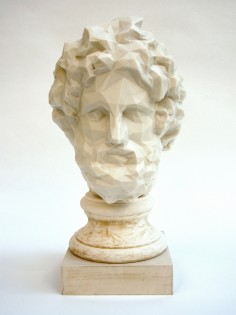Zachary Eastwood-Bloom
Fractured

source: dazeddigital
For centuries, Italy’s marble carvers have been perfecting their sculpture game. Blood, sweat and tears go into their masterpieces, gracing museums and galleries worldwide. Their craft, however, is now under threat. Ish. Enter Zachary Eastwood-Bloom, the ceramics specialist who founded East London’s Studio Manifold, who uses 3D printers to create sculptures that would ordinarily take years to create – as seen in his RA Edition Asklepios (2014). Rather than showing the raw, printed object, Eastwood-Bloom fuses the past and the future in his contemporary sculptures – using the 3D prints as a mould that are then used with traditional materials, such as clay and bronze.
.
.
.
.
.
.
.
source: zacharyeastwood-bloom
Zachary Eastwood-Bloom is a London based artist who explores the blurring space between the material and digital worlds. He works with various materials and processes as well as sound and video. In 2004 he graduated with a BA(Hons) from Edinburgh College of Art and an MA from the Royal College of Art in 2010.
Zachary has exhibited with the Royal Academy of Arts, the V&A Museum and the Royal British Society of Sculptors, and was recently awarded the Jerwood Makers Award 2015. Zachary is also the Pangolin Artist in Residence 2015/2016.
In 2010, Zachary co-founded Studio Manifold; a collective of nine artists and designers who founded a studio in an east London railway arch.
.
.
.
.
.
.
.
source: exlaborguk
Zachary Eastwood-Bloom is a multi-material artist working with and exploring materials such as concrete, ceramic, bronze, wood and resin. He combines both traditional and contemporary processes such as casting, CNC milling, 3D printing and laser cutting, making objects that question the delicate balance between the material and the digital. After discovering the possibilities of making and the three dimensional form Zachary went to study at Edinburgh College of Art where he began experimenting with 3D design software. He further explored digital processes and fabrication at the Royal College of Art graduating in 2010.
Zachary is a founding member of London based Studio Manifold and has recently exhibited with British Ceramics Biennial, The V&A Museum and The Royal British Society of Sculptors and his piece ‘Information Ate My Table’ is currently touring with the Crafts Council’s Lab Craft exhibition.
I am very keen to explore the diverse possibilities of using scientific data and instrumentation to stimulate form creation. The prospect of working and being in dialogue with scientists is a very exciting notion.
Zachary Eastwood Bloom works with both traditional making methodologies and what he terms ‘post-craft’ processes of production. Access to landscape scanning processes used in geology have opened up new ways of working for Zachary which has resulted in both 2D and 3D renderings and models, as well as an innovative audio work derived from landscape scanning sources. Both the audio installation presented in the tower of Durlston Castle and the works at Walford Mills Crafts represent his keen interest in synaethesia.
Zachary was selected for ExLab because his work offers a fresh approach to craft and challenges preconceptions about what the term ‘craft’ embraces. He combines traditional haptic methods of making with highly technical processes of production. Often his work is actually about that collision between hand made and machine-made. ‘Information Ate My Table’ is a good example of this.
Zachary is a founding member of London based Studio Manifold and has recently exhibited at the British Ceramics Biennial, the V&A Museum and The Royal British Society of Sculptors and his piece ‘Information Ate My Table’ recently toured with the Crafts Council’s Lab Craft exhibition. His work utilises materials such as concrete, ceramic, bronze, wood and resin. He combines both traditional and contemporary processes such as casting, CNC milling, 3D printing and laser cutting, making objects that question the delicate balance between the material and the digital. Zachary studied at Edinburgh College of Art where he began experimenting with 3D design software. He further explored digital processes and fabrication at the Royal College of Art for his Masters, graduating in 2010. Having made The Journey (2010), a work that transcribed sound into landscape, for ExLab he has reversed that process, creating sound from landscape.
Zachary is now exploring a cycle of this activity with the New English Ballet Theatre – whereby the orchestra generates form and the performers respond to the resulting virtual landscapes. Zachary considers his work to be a form of synaethesia. He sets out to transgress the senses, creating sound from form, form from sound, images and sculptures from data. During his research for ExLab he worked closely with geologists and natural scientists at Durlston, all of which has informed this new body of work. He commented on how fascinating it was that all those he engaged with at Durlston had very personal, and different, experiences of the same landscape. That knowledge conceptually underpins how he works across mediums and how he experiences place – there is no universal ‘knowing of landscape’ that we all share in common, but only our ‘interpretation of a landscape’. This is also applied to the mediums he employs – there is no ‘correct’ way to use them. Many of the works for ExLab reflect his use of various mediums – high-end technology provides visual readings of landscapes – which Zachary has modified to create prints closely akin to colour-field paintings. He straddles the digital and the analogue, design, making and contemporary art. He makes things that have not been seen before, by merging and morphing media and material, the haptic and the hi-tec.
The diversity of his work is reflected across the two venues, which provide different contexts too. For example, sections of the Durlston landscape were scanned, generating digital data has been 3D printed- Fragments from a Digital Earth’- and exhibited alongside a sound piece – Rendered Earth – that has also been generated from the shoreline.

